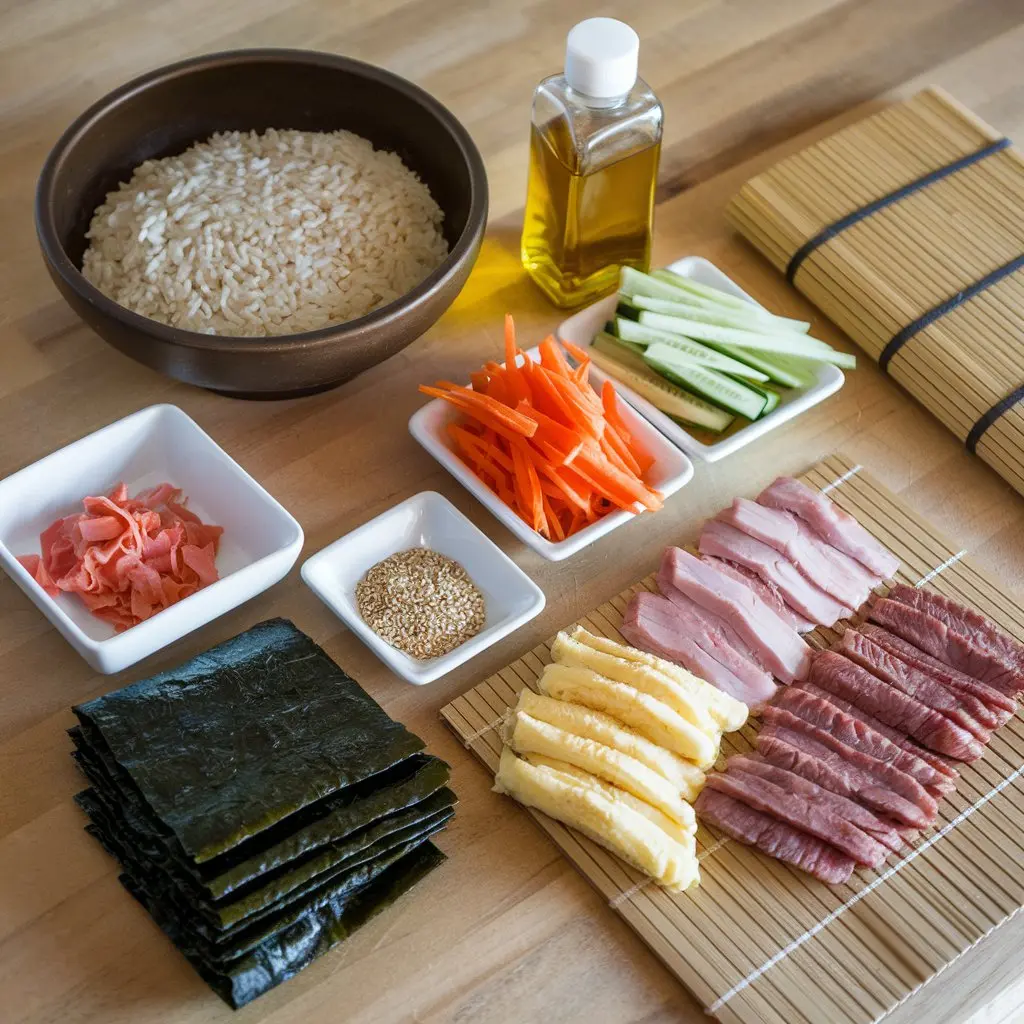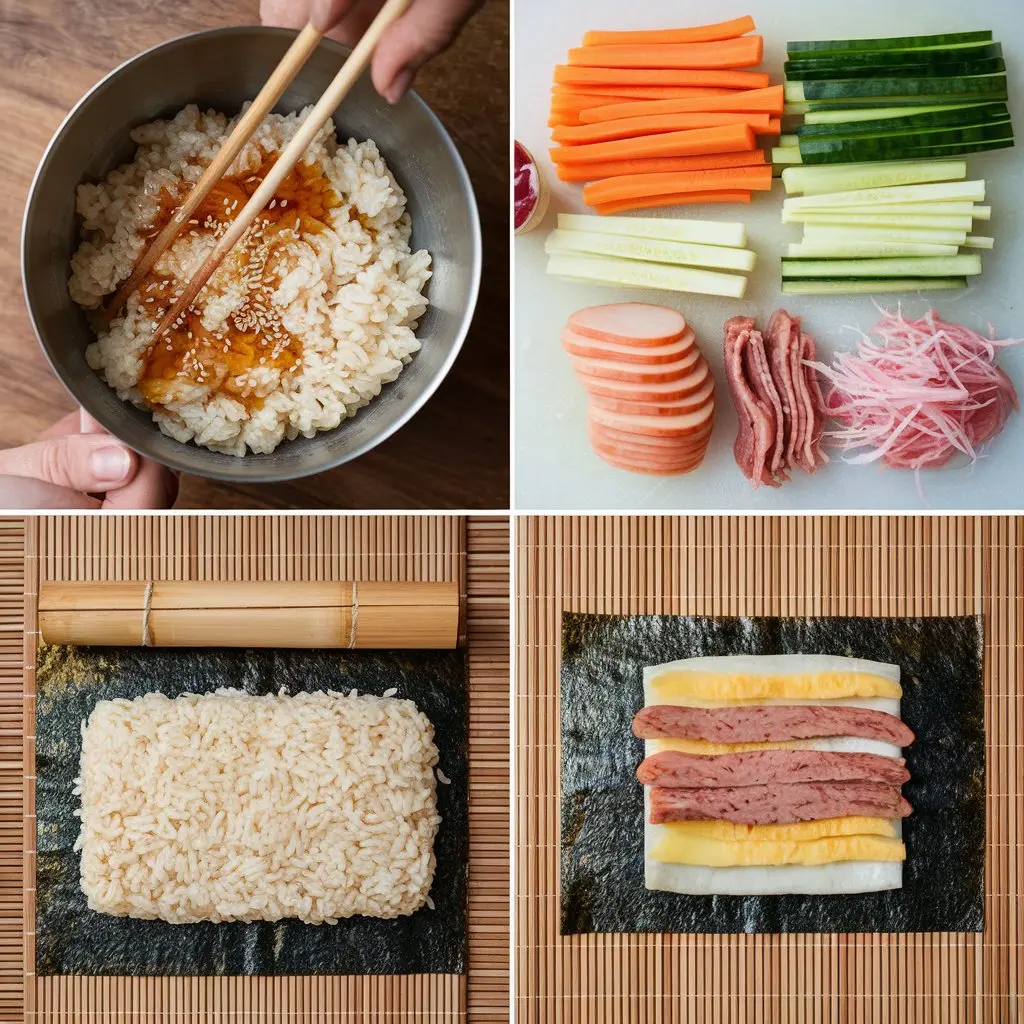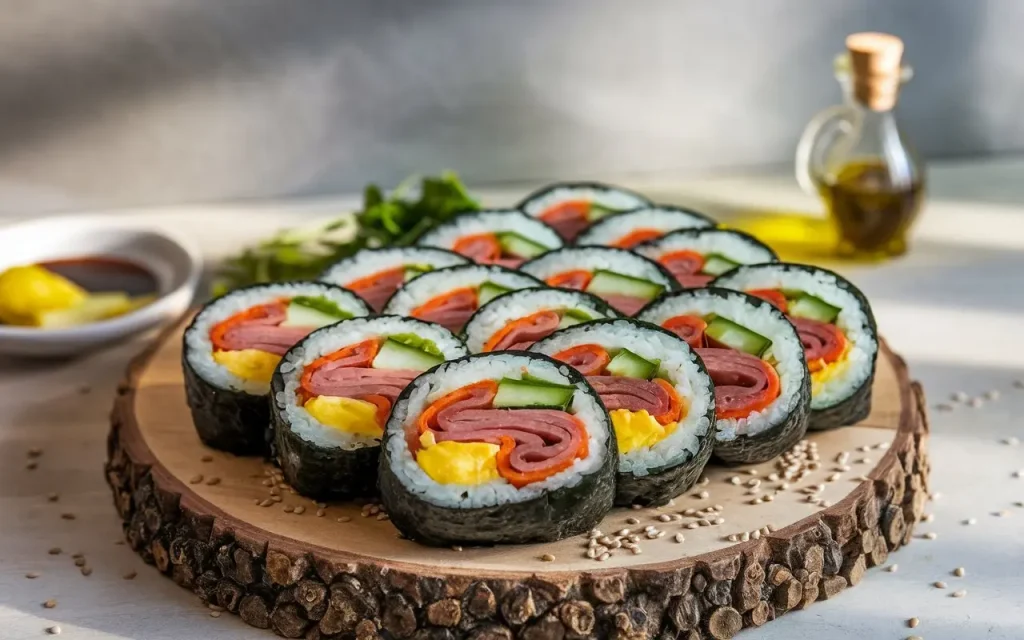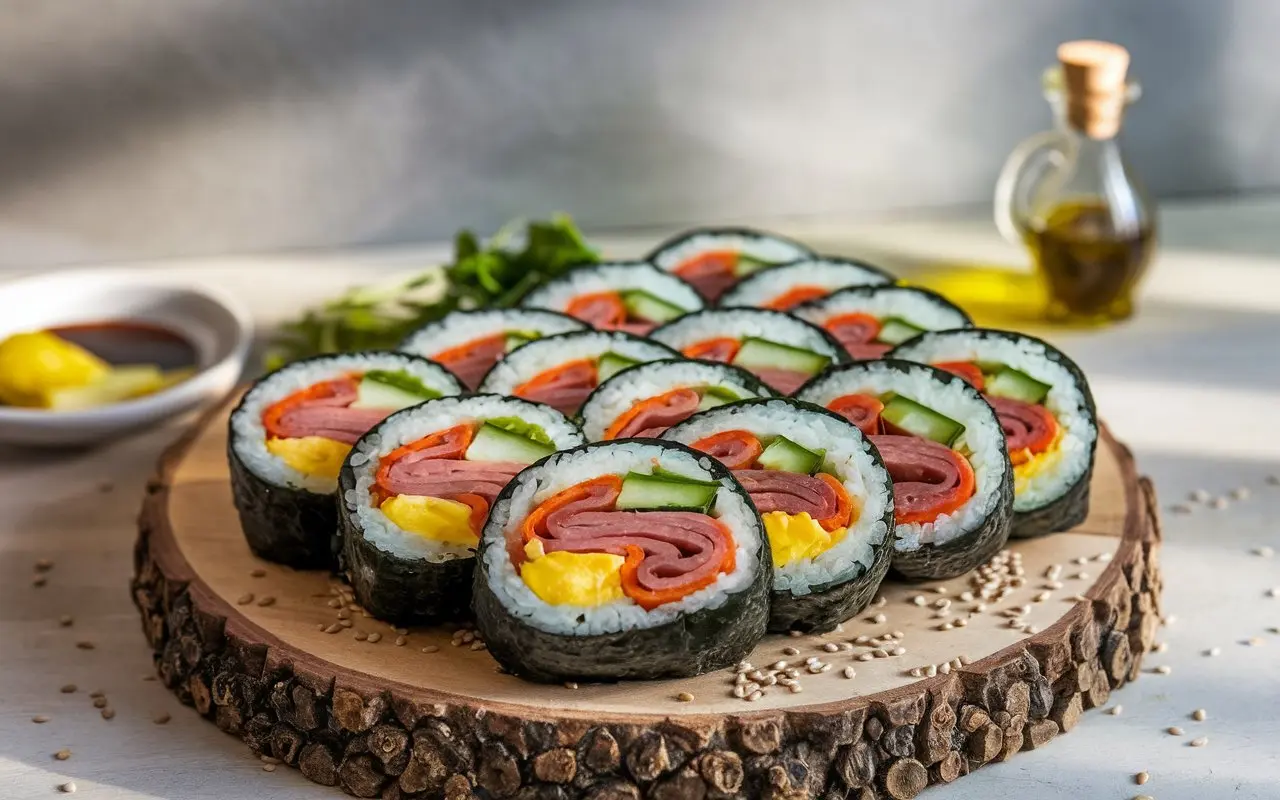Kimbap Near Me Recipe: Your Ultimate Guide to Making Authentic Kimbap at Home
If you’ve ever found yourself craving the delicious and satisfying flavors of kimbap Recipe, you’re not alone. This popular Korean dish, often compared to sushi, has become a beloved snack and meal option worldwide. However, instead of searching for “kimbap near me,” why not learn to make it yourself? In this comprehensive guide, we’ll teach you how to make homemade kimbap from scratch, step by step, so you can enjoy it anytime, anywhere.
From learning about the ingredients to mastering the rolling technique, we’ll cover everything. We’ll also share some pro tips to help you customize your kimbap and give it your personal twist. Plus, we’ve included internal links to other delicious recipes on our blog to inspire your next culinary adventure. So, let’s dive right in and get rolling!
What is Kimbap
Kimbap, sometimes spelled gimbap (김밥 in Korean), is a traditional Korean dish that consists of rice (bap) and various fillings rolled in seaweed (gim). It’s a popular picnic food in Korea and is often enjoyed as a snack or light meal. The key to great kimbap is the balance of flavors and textures: the slightly salty and nutty rice, the crisp vegetables, and the savory proteins.
While kimbap might look similar to Japanese sushi, there are several key differences. The rice in kimbap is seasoned with sesame oil and a pinch of salt, whereas sushi rice is typically flavored with rice vinegar. Kimbap also tends to include cooked ingredients like egg, spinach, and beef rather than the raw fish often found in sushi.
You can find kimbap at Korean restaurants, street vendors, and even convenience stores, but there’s something special about making it at home. Not only can you customize the fillings to your liking, but you’ll also have the satisfaction of creating a delicious, healthy meal from scratch.
Why Make Kimbap at Home?
Making kimbap at home is a fun and rewarding experience. It’s perfect for family gatherings, picnics, or even just a solo lunch. Plus, it’s incredibly versatile — once you know the basics, you can experiment with different ingredients to create your own unique versions.
By making kimbap at home, you can:
- Control the ingredients, ensuring everything is fresh and to your taste.
- Customize the fillings based on dietary preferences (vegetarian, vegan, or even gluten-free).
- Save money compared to buying it at restaurants or stores.
- Share a fun cooking experience with friends and family.
Now, let’s move on to the ingredients and tools you’ll need to create your own perfect kimbap.
Ingredients for Kimbap

For the Rice:
- 2 cups of short-grain rice (sushi rice or any sticky rice)
- 2 tablespoons of sesame oil
- 1 teaspoon of salt
- 1 tablespoon of sesame seeds
For the Fillings:
- 4-5 sheets of dried seaweed (nori)
- 1 large carrot, julienned
- 1 cucumber, cut into thin strips
- 4 eggs, scrambled and sliced into thin strips
- 4 slices of ham, bulgogi (beef), or tofu for a vegetarian option
- 4 strips of pickled radish (danmuji)
- Optional: blanched spinach, crab sticks, or other vegetables
You can be as creative as you like with the fillings. Traditional kimbap includes ingredients like beef, egg, pickled radish, and vegetables, but you can switch things up depending on your preference. For instance, you could add spicy tuna, kimchi, or even cheese for a more modern twist. Some great flavor combinations can also be found in our Low-Calorie Mac and Cheese recipe, which offers a healthy yet flavorful approach to comfort food.
Tools You’ll Need
To make kimbap recipe, you don’t need many tools, but there are a few essentials that will make the process easier:
- Bamboo Rolling Mat: This will help you roll the kimbap tightly and evenly.
- Sharp Knife: A sharp knife is essential for cutting the kimbap without squishing it.
- Rice Cooker: While you can cook rice on the stovetop, a rice cooker simplifies the process and ensures perfect, sticky rice every time.
- Cutting Board: For preparing your fillings.
- Small Bowl of Water: For sealing the nori sheets.
Step-by-Step Guide to Making Kimbap Recipe
Now that you have your ingredients and tools ready, let’s start making your delicious homemade kimbap.

1. Prepare the Rice
Cook the short-grain rice in a rice cooker or on the stovetop until it’s sticky but not mushy. Once cooked, let the rice cool slightly before seasoning it with sesame oil, salt, and sesame seeds. Mix well, ensuring the flavors are evenly distributed.
If you’re curious about using healthier options, you might want to check out this Creamy Potatoes and Mushrooms recipe, which focuses on hearty but health-conscious choices.
2. Prepare the Fillings
While the rice is cooking, you can prepare your fillings. Here’s how to handle some of the most common ingredients:
- Carrots: Julienne the carrots and lightly sauté them in a bit of oil until they’re tender but still slightly crisp.
- Cucumbers: Cut the cucumbers into long, thin strips. You can leave the skin on for extra crunch.
- Eggs: Scramble the eggs and slice them into thin strips once cooked.
- Ham/Bulgogi/Tofu: Slice your protein thinly, ensuring it’s the right size for rolling.
For a fun fusion twist, try pairing your kimbap with a Sweet Potato Ukoy with Palabok. This recipe, which can be found here, offers a unique combination of flavors that would complement your kimbap Recipe beautifully.
3. Assemble the Kimbap Recipe
Lay a sheet of nori on your bamboo rolling mat with the shiny side down. Spread a thin layer of rice over the nori, leaving about an inch of space at the top. The rice should cover the nori evenly, but avoid making the layer too thick, as it can make rolling difficult.
Once your rice is spread out, it’s time to add the fillings. Arrange the vegetables, protein, and pickled radish in a horizontal line near the bottom third of the nori sheet. Don’t overfill the kimbap, as this can make it hard to roll tightly.
4. Roll the Kimbap
Use the bamboo mat to start rolling the kimbap from the bottom, pressing down gently to keep the roll tight. As you roll, make sure to tuck the fillings in so they don’t spill out. Once you’ve rolled the kimbap to the top, wet the inch of nori that you left bare to seal the roll.
You’ll need to apply consistent pressure as you roll to ensure everything stays in place. Once you’ve finished rolling, give the roll a gentle squeeze to make sure it’s secure.
5. Slice and Serve
Using a sharp knife, slice the kimbap into bite-sized rounds. To prevent the rice from sticking to the knife, wipe the blade with a damp cloth between each cut. Arrange the kimbap slices on a platter and serve with soy sauce, kimchi, or additional pickled radish.
Kimbap is best enjoyed fresh, but you can also store it in the fridge for up to 24 hours. Just wrap it tightly in plastic wrap to prevent the rice from drying out.
Variations and Customization
One of the best things about kimbap is how customizable it is. Once you’ve mastered the basic technique, feel free to get creative with your fillings. Here are some popular variations:
- Vegetarian Kimbap: Swap out the meat for tofu or tempeh. You can also add extra veggies like spinach, bell peppers, or avocado.
- Spicy Kimbap: Add some heat by incorporating spicy tuna or a drizzle of sriracha sauce.
- Seafood Kimbap: If you love seafood, consider adding crab sticks or cooked shrimp to your kimbap for a delicious twist.
- Fusion Kimbap: Try blending different cuisines by adding unconventional ingredients. A fun example of fusion is the Hamburger Casserole Recipe, where various ingredients come together to create a hearty, satisfying dish. Who says you can’t bring a bit of that creativity into your kimbap?
Kimbap Recipe Nutrition Facts
Kimbap is not only delicious but also a well-balanced
and nutritious meal. It contains a healthy mix of carbohydrates, protein, and vegetables, making it a filling yet light option. Here’s a quick breakdown of the nutritional benefits of some of the key ingredients:
- Rice: Provides energy and a small amount of fiber. Opting for brown rice can increase the fiber content.
- Carrots and Cucumbers: These vegetables are high in vitamins A and C, and they add a satisfying crunch.
- Eggs: A great source of protein, vitamins, and healthy fats.
- Pickled Radish (Danmuji): Low in calories but high in fiber and vitamin C.
- Sesame Oil: Rich in antioxidants and healthy fats, sesame oil also adds a nutty flavor that enhances the overall taste of the kimbap.
If you’re curious about other health-conscious recipes, you might enjoy our Chicken Pot Pie in Phyllo Pastry, which uses a light, crispy phyllo dough for a healthier version of this classic comfort food.

Storage and Serving Suggestions
While kimbap is best eaten fresh, it can be stored in the fridge for later consumption. Here are some tips for storing and serving kimbap:
Storing Kimbap:
- Wrap the rolls tightly in plastic wrap to keep the rice soft and prevent the nori from becoming too soggy.
- Store in an airtight container and refrigerate for up to 24 hours. Kimbap stored for longer than this may start to lose its flavor and texture.
Serving Kimbap:
- For a traditional Korean meal, serve kimbap with a side of kimchi or pickled vegetables.
- Kimbap can also be paired with other Korean dishes like tteokbokki (spicy rice cakes) or bulgogi.
- If you want to take your meal to the next level, try serving your kimbap alongside some of our other breakfast and brunch variations. The sweet and savory combinations work wonderfully with the mild flavors of kimbap.
Final Thoughts: Your Kimbap Journey Starts Here
Making kimbap at home is easier than you might think, and it opens up a world of culinary possibilities. Once you’ve mastered the basics, you’ll find that the potential for customization is endless. Whether you’re making a traditional version or experimenting with new ingredients, kimbap is a dish that’s sure to impress.
Instead of searching for “kimbap near me,” you now have the knowledge and confidence to make this delicious Korean dish right in your own kitchen. So grab your bamboo mat, gather your ingredients, and start rolling!
And don’t forget to explore other recipes on our blog, such as the Grinch Cake Recipe, which is perfect for a festive dessert after your kimbap Recipe feast!
Happy cooking, and enjoy your homemade kimbap adventure!

